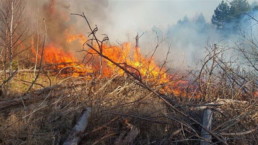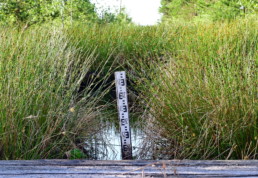Who’s awake in the woods at night? New study analyses the diel activity of carnivores
The coexistence of wildlife and people in Europe's human-dominated landscape is a complex phenomenon. Protected areas are relatively small and they intermingle with areas of high human disturbance. This leads animals to use various adaptation mechanisms, including increasing their nocturnal activity. The recent study supported by our project analyses for the first time the diurnal activity of wolves and lynx along a gradient of human disturbance to reveal the correlation between anthropogenic pressure and animals’ temporal behavior.
A growing human presence in wildlife areas is particularly critical for large carnivores with large home ranges, such as the wolf and Eurasian lynx. Increasing nocturnal behaviour is one of the strategies that allows these animals to avoid risky interactions with humans. This behavioural adaptation mechanism has been described before. However, the new study is the first attempt to analyse the diurnal activity of the two carnivore species in a number of areas that differ in character and intensity of human presence – from areas of intense anthropogenic pressure to those where human activity is highly restricted.
Understanding the behaviour of large carnivores and the factors that cause them to change their mode of living is important from a number of perspectives. On the one hand, if human disturbance causes carnivores to shift their activity to the nocturnal period, this could affect their interactions with prey, with potentially significant consequences for the ecosystem. On the other hand, in human-dominated landscapes, nocturnal behaviour reduces negative human-animal interactions and thus benefits the conservation of carnivores by enabling their conflict-free coexistence.
Previous studies have shown that both wolves and lynx are predominantly nocturnal in Europe and have suggested that anthropogenic factors may influence their temporal behaviour. However, no attempt has been made to analyse the diurnal activity of carnivores in the context of a comparison between areas with different levels of anthropogenic pressure.
The authors of the new study suggested that both wolves and lynx would be more active during the day under conditions of low anthropogenic pressure and the probability of being active at night would rise as human disturbance increased. To test this hypothesis, the researchers analysed images from camera traps deployed at nine sites in six European countries with a gradient of anthropogenic pressure.
Remarkably, two of these sites are located in Polesia: the Ukrainian part of the Chornobyl Exclusion Zone and Pripyat-Polesia in Belarus. The lowest indices of human disturbance were expected to be found in the Chornobyl Exclusion Zone (Ukraine), which was used as a baseline for wolf and lynx behaviour. Human activity in this area is extremely low due to decades of restricted human access following the Chornobyl nuclear accident in 1986. Camera trap data was also collected in central Belarusian Pripyat-Polesia (Belarus), Białowieża Primeval Forest (Poland), Tuchola Forest Complex (Poland), Bieszczady National Park (Poland), Skolivski Beskydy National Park (Ukraine), Bavarian Forest National Park (Germany), Plitvice Lakes National Park (Croatia) and Maremma Regional Park (Italy). All these areas are disturbed to a greater or lesser extent by various anthropogenic factors and their combinations, such as forestry, hunting, agriculture or tourism.
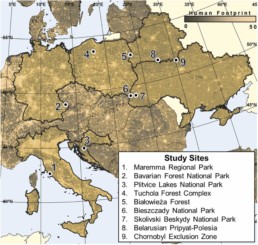
The data collected covers several years, from 2014 to 2022, focusing on the period from September to April, when large carnivores are usually monitored. Cameras were deployed along forest roads and trails used both by carnivores and people.
The analysed data set comprised more than 71,000 independent encounters, including 2,430 of wolves, 934 of lynx, 8,585 of prey species, and 59,408 of humans. The highest rate of human encounter was recorded in the Bavarian Forest National Park, while the lowest was in the Skolivski Beskydy National Park, followed by the Chornobyl Exclusion Zone.
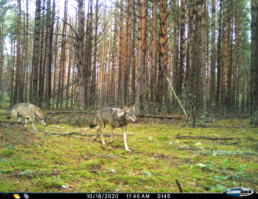
The researchers found out that wolves in all the study sites were rather nocturnal than diurnal. As expected, wolves in our baseline study area in the Chornobyl Exclusion Zone showed the highest levels of daytime activity. In Skolivski Beskydy and Białowieża National Parks, wolves were the second-most diurnal, while wolves in Belarusian Pripyat-Polesia were the most nocturnal. It is noteworthy that the latter area is characterised by the highest level of anthropogenic pressure and wolf hunting is allowed all year round. Apart from the human encounter rate, no human disturbance factors, such as human population or road density, explained higher activity of wolves at nighttime at the landscape level.
Lynx were consistently nocturnal in all study sites. However, lynx in the Chornobyl Exclusion Zone were not the most likely to be observed at daytime: lynx in the Plitvice Lakes National Park had the highest probability of observation during the day, while lynx in the Bavarian Forest National Park were the most nocturnal. The data obtained indicates that the nocturnal habit of the lynx does not depend on the type and level of human disturbance.
The results of the study show that wolves change their temporal behavior in response to human pressure, but lynx don’t. This is most likely due to differences in their predation ecology.
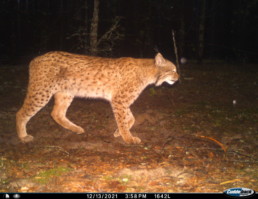
Although they often prey on the same species, wolves and lynx have different hunting strategies. As cursorial predators, wolves rely on pursuit tactics. However, they can also use the stalk and ambush strategy, which is most effective in low light conditions. Wolves’ hunting success is generally highest at twilight, but it is likely that some wolves have improved their hunting success at daytime. In addition, the social behaviour of wolves can also influence their way of life, as they can hunt alone or in packs. As a predominantly solitary, ambush predator, the lynx fits well into the nocturnal-crepuscular niche because darkness allows it to implement its hunting strategy most effectively.
Areas of restricted human access in Europe are unlikely to expand in the near future. However, populations of large carnivores such as wolves and lynx are increasing and recolonising areas where they were previously extinct. This allows researchers to predict that populations of such species will continue to exhibit predominantly nocturnal behaviour in areas with high human presence, in order to minimise potentially dangerous interactions with humans. Understanding the daily activities of animals will help to develop effective strategies for carnivore conservation and the creation of a landscape of conflict-free coexistence between humans and wildlife.
Adam Francis Smith, Research and Monitoring Coordinator at the Frankfurt Zoological Society, one of the study’s authors:
“The most valuable result to me is managing people’s expectations of large carnivores. It is common to assume that wolves are just creatures of night time, but ultimately it is our impacts on the landscape, mostly during daytime, which confine them to night. Wolves are intelligent and adaptable to different human pressures. However, Eurasian lynx are mostly ambush predators, so being active at night fits their predation mode very well. Ultimately, this type of study wouldn’t be possible without access to great colleagues and data from a wide range of areas.
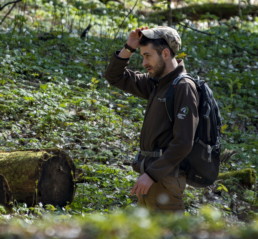
If we confine wolves to night because of human disturbance during the day, we can expect different behaviours. If we want to allow the full range of wolf behaviours, or in other words, to allow them to choose when to be active, we must decrease our disturbance in time as well as space. So, the most obvious next steps are to look at how these human disturbances influence other aspects of wolf and lynx biology. For example, is the hunting success lower in more nocturnal populations? What about the size of family groups? These are important questions for finding the balance between human disturbance and the capabilities and persistence of large carnivores in Europe.”
Safe and intact: protecting rare and typical habitats in Polesia
19. September 2025
0 Comments7 Minutes
Smith, Adam & Kasper, Katharina & Lazzeri, Lorenzo & Schulte, Michael & Kudrenko, Svitlana & Say-Sallaz, Elise & Churski, Marcin & Shamovich, Dmitry & Obrizan, Serhii & Domashevsky, Serhii & Korepanova, Kateryna & Bashta, Andriy-Taras & Zhuravchak, Rostyslav & Gahbauer, Martin & Pirga, Bartosz & Fenchuk, Viktar & Kusak, Josip & Ferretti, Francesco & Kuijper, D.P.J. & Heurich, Marco. (2024). Reduced human disturbance increases diurnal activity in wolves, but not Eurasian lynx. Global Ecology and Conservation. e02985. DOI:10.1016/j.gecco.2024.e02985



